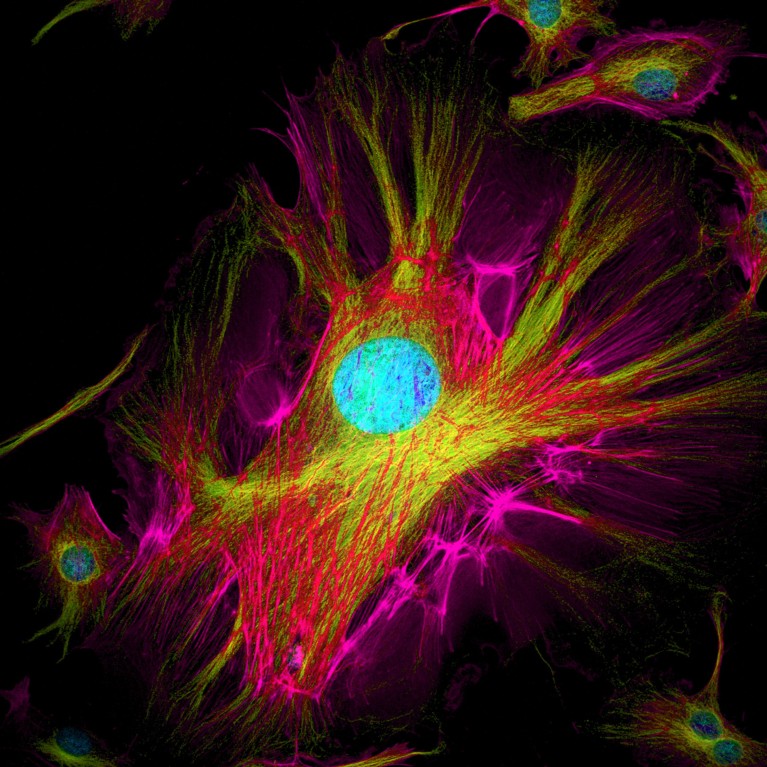
Fluorescent dyes can help researchers to visualize the structure of a cell — but it can be difficult to use more than a handful.Credit: David Becker/SPL
When working with fluorescent dyes or proteins, researchers typically focus on two variables: the wavelength of light at which the molecules are stimulated to fluoresce, and the wavelengths at which they emit light — that is, their colour. By balancing those properties, researchers can distinguish between half a dozen or so fluorescently tagged molecules in the same sample.
But there’s more to fluorescence than colour, and scientists can now more easily use another property of fluorescent molecules to increase the number of proteins that can be visualized at the same time.
Led by Xin Zhang, a chemist at Westlake University in Hangzhou, China, the team designed more than two dozen fluorescent proteins that differ not only by colour, but also in how much time they spend in their excited state — a property called the fluorescence lifetime. The researchers call these molecules time-resolved fluorescent proteins, or tr-FPs. Their findings were published online last month in Cell1.
“It’s brilliant work,” says Conor Evans, a physical chemist at Massachusetts General Hospital and Harvard Medical School in Boston. The team has given researchers a “dial-able palette” from which they can pick both a colour and a lifetime to get what they need, he says. “That’s very powerful.”
Expanding the palette
Suppose that a scientist wants to map a cellular process associated with a specific protein. To work out where in the cell that process occurs, the researcher can use fluorescent dyes to highlight cellular landmarks — blue for the nucleus, red for the cytoskeleton and green for the mitochondria, for instance. Viewing other proteins of interest against this background would require still more colours. However, because the visible spectrum is relatively narrow and fluorescent molecules emit light over a range of wavelengths, standard microscopes can handle only a handful of colours simultaneously. After that, the emission spectra start to bleed together, making it difficult to discern which signals are coming from which molecule.
The fluorescence lifetime provides a way to expand that palette.
When a fluorescent molecule absorbs light, its electronic energy levels increase to enter what is called the excited state. The molecule hovers in this excited state for pico- to nanoseconds, and then begins its luminous descent to the ground state, emitting excess energy in the form of photons. The time a molecule spends in an excited state — that is, between absorbing and emitting photons — is called the lifetime.
To change the lifetimes of existing fluorescent proteins, Zhang’s team mutated some of the amino-acid residues to destabilize the region in which the fluorescent signal is generated. The researchers then screened the resulting proteins to identify variants with different lifetimes, but identical emission spectra, to those of their wild-type counterparts. In all, they produced 28 variants, spanning most of the visible spectrum.
Zhang’s group then put this palette to work, fusing the tr-FPs to various target proteins and testing their behaviour in various subcellular locations. They also examined how the tr-FPs performed in a wide range of applications, including super-resolution microscopy, and showed that the technology enables live-cell imaging of nine target proteins using only three colour channels.
Zhang notes that lifetime-based imaging is not a new concept, but he hopes the tr-FPs will help more researchers to take advantage of the technique. “I think this is more like an addition to the broad and powerful family of fluorescent proteins,” he says, rather than some kind of paradigm shift.
The researchers did, however, test the tr-FPs in what they say is a new application: quantifying the relative concentrations of two proteins in a single living cell, something that is difficult to determine from fluorescence intensity alone.


